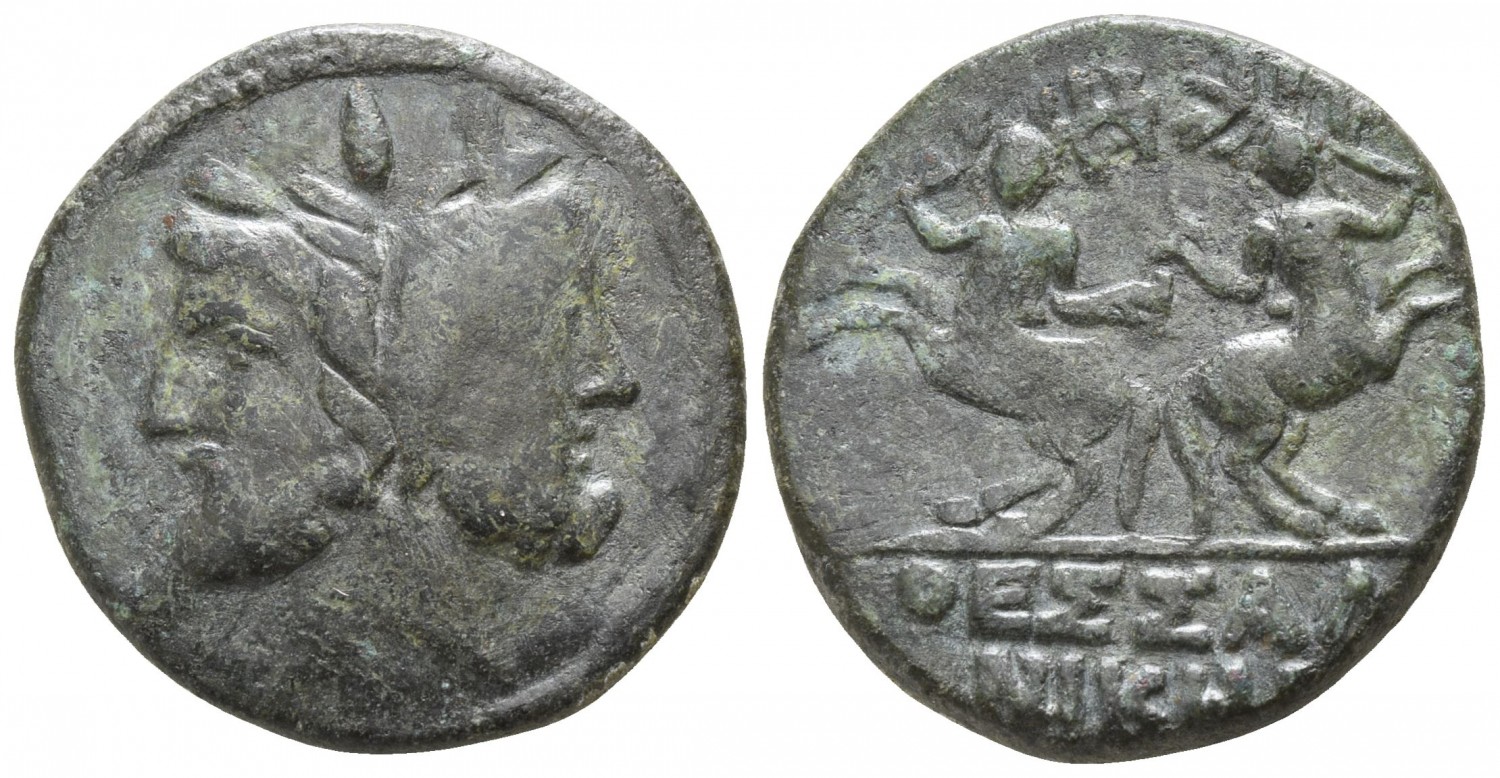Thessalonica (Roman Republic), bronze, ca 16g (head of Janus/riding Dioscuri) (120-100 BCE)
From SILVER
(Redirected from S 1334 - Thessalonica, bronze, 120-100 BC)
120 BCE - 100 BCE Bronze
Description
| ObverseInscription or printing placed on the obverse.: | Head of Janus. |
| ReverseInscription or printing placed on the reverse.: | ΘΕΣΣΑΛΟΝΙΚΗΣ (Greek).The Dioscuri riding in opposite directions |
Mint and issuing power
| MintIdentifies the place of manufacture or issue of a numismatic object.: | Thessalonica | Ancient regionAncient region.: | Macedon | Modern countryModern country: Greece | AuthorityIdentifies the issuing power. The authority can be "pretended" when the name or the portrait of X is on the coin but he/she was not the issuing power. It can also be "uncertain" when there is no mention of X on the coin but he/she was the issuing power according to the historical sources: | Roman Republic |
Chronology
| FromIdentifies the initial date in a range assigned in a numismatic context. | 120 BCE | toIdentifies the final date in a range assigned in a numismatic context.. | 100 BCE | PeriodTime period of the numismatic object.: Hellenistic 323-30 BC |
Physical description
| MetalThe physical material (usually metal) from which an object is made.: | Bronze |
Median weightMedian of the weights of numismatic objects (in grams). in grams | 16.00 | DenominationTerm indicating the value of a numismatic object. Examples: tetradrachm, chalkous, denarius.: | StandardStandard.: |
Image

Thessalonica_Janus_Dioscuri.jpg [1]
References
| Die study referencePublication of the study: | Kourempanas 20161Kourempanas 2016, TYPE 7 | ||
| Coin series referenceReference to coin series study: | |||
| Coin series web referenceCoin series web references: | |||
Obverse dies distribution
| FrequencyFrequency of specimen in distribution. ᵖ | Number of obversesNumber of obverse dies. ᵖ (o) | % (o) | Number of coinsNumber of coins. (n) | % (n) | Die nameName(s) of the die(s). |
| 1 | 1 | 11.11 | 1 | 3.45 | E6 |
| 2 | 2 | 22.22 | 4 | 13.79 | E7, E9 |
| 3 | 2 | 22.22 | 6 | 20.69 | E2, E5 |
| 4 | 3 | 33.33 | 12 | 41.38 | E3, E4, E8 |
| 6 | 1 | 11.11 | 6 | 20.69 | E1 |
| Total | 9 of 9 | 99.99 | 29 of 29 | 100 |
Reverse dies distribution
no distribution is available
Quantification
| Number of obversesNumber of obverse dies. ᵖ (o) | 9 | Number of singletons (o1)The number of singleton coins. ᵖ | 1 |
| Number of reverse diesNumber of reverse dies. (r) | 19 | Number of coinsNumber of coins. (n) | 29 |
| Coins per obverse dieNumber of coins per obverse die. (n/o) | 3.22 | Coins per reverse dieNumber of coins per reverse die. (n/r) | 1.53 |
| Reverse per obverse ratioRatio of obverse dies divided by reverse dies. (r/o) | 2.11 | Percentage of singletons (o1)number of coins (n) divided by the number of singletons (o1) ᵖ | 11.11 % |
| Original number of dies (O) (Carter 1983 formula)The estimation of the number of coins according to Carter 1983 ᵖ | 11.15 | Coins struck if 20,000 as average productivity per dieCoins made if the average productivity for obverses (according to Carter) is 20,000. ᵖ | 223,000 |
| Original number of dies (O) (Esty 2011 formula)The estimation of the number of coins according to the singleton formula in Esty 2011 ᵖ (O) | 13.05 | Survival rate if 20,000 as average productivity per dieSurvival rate if average productivity is 20,000. ᵖ | 0.00013 |
| Coverage (o = % of O) (Esty 1984 formula)Esty 1984 - coverage (% of O) ᵖ (o = % of O) | 96.55% | Die productivity if survival rate 1/2,000Average productivity if survival rate is 1/2,000. ᵖ | 5,201.79 |
| Weight of silver (in kg) if 20,000 coins per die (O = Carter formula)Carter 1983 * Median weight * 20000 (*10 if gold or electrum) ᵖ | n.a. | Die productivity if survival rate 1/5,000Average productivity if survival rate is 1/5,000. ᵖ | 13,004.48 |
Remarks
Most likely one single workstation
References
- ^ Kourempanas, Theodoros (2016), "Τα ελληνιστικά νομίσματα της Θεσσαλονίκης" , Athens, p. 112, pl. 13.